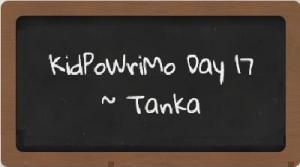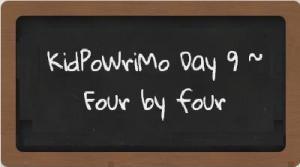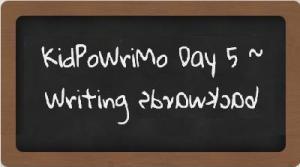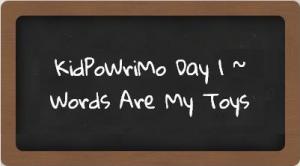Our Wednesday haiku adventures have led us first to 5-7-5 (17 syllable haiku) and then to six word haiku. I would rather not use the word “haiku” to describe poems that are much larger than 17 syllables because there are larger forms of poetry. These poems could fit into these other descriptions. Tanka is one of these slightly larger poetic forms.
Poetic word of the day: tanka (click here to see this word defined on Dictionary.com)
The easiest way to describe tanka is to add two 7-syllable lines to the American 5-7-5 haiku format.
So, you will have five lines and the syllables per line will be in this order: 5-7-5-7-7.
Although this is 14 syllables larger than haiku and you get to say almost twice as much as you can say in a 5-7-5 haiku, I encourage you to make the most of all the syllables you have just as you would be when writing haiku.
If you have any haiku that you think need more words to be the poem you want it to be, try remixing it into a tanka.
You may start by moving the lines around. The five syllable lines can switch places and the seven syllable line can go in one of three places in the tanka. You may also add two syllables to one or both of the five syllable lines. Then once you write whatever lines are missing, you will have a tanka.
Let’s go through this creative process together. I will create as I write.
PROMPT: Write a tanka poem by remixing an existing haiku by you or someone else.
I am going to remix a 4-line haiku poem entitled “Bad Morning” by Langston Hughes into my own tanka (the title and author’s name link to the poem on the All Poetry site). I like his haiku because he sneaked in a rhyme.
Pick your haiku or write one to get started.
Here is my version of Langston Hughes’ 17 syllables. I have reworked them into 3 lines:
(5) Oh, Lord have mercy!
(7) I’m sitting here frustrated
(5) Shoes are mis-mated.
Next, I will write an original haiku poem inspired by this one:
(5) No tissues in sight,
(7) I need to suppress a sneeze!
(5) Heaven help me please!
by Cheryl Crockett inspired by Langston Hughes’ “Bad Morning”
Notice, my haiku has a different topic and is unique and original.
Next, I can take take one or both of my 5 syllable lines and make them into 7 syllables by adding two.
(7) THERE ARE no tissues in sight
(7) OH LET heaven help me please!
As I build my tanka, I can use these lines in either of their 5 or 7 syllable forms, edit them again or write new lines.
Now, my haiku has a complete message, but as a tanka, it needs more information. I will think about other things that accompany a sneeze and a need for tissues or a substitute for tissues. This will help me create a word list that I can expand into phrases.
(1) Cold
(1) Flu
(1) Dust
(2) Shirt sleeve
(2) Paper
(2) Towels
(2) Pollen
(2) Disease
(3) Allergies
(3) Infection
(3) Contagious
(4) Toilet tissue
Now I can finish my tanka by expanding my haiku:
(5) Pollen fills my lungs.
(7) There are no tissues in sight.
(5) But with all my might,
(7) I need to suppress a sneeze!
(7) Oh, let heaven help me please!
by Cheryl Crockett
How did your tanka develop? If you would like to share it, feel free to do so as a comment below this post.
FOR PARENTS OF YOUNGER CHILDREN: Read some haiku that you have written using the prompts earlier during #KidPoWriMo, or find some on the internet. You can do this by typing “HAIKU” into your favorite search engine. Talk to your child(ren) about each haiku and ask them what else might have happened before, during or after the story or message in the haiku. Help your child(ren) to create 7 syllable lines based on the details they imagine. Add these lines to the haiku to make a tanka.
With each of these exercises, because your children may need help writing from an older person, make sure to tell them that you are “making poetry together“. This tradition will stay with them and they will understand that poetry is important to you and it will become important to them, too.



